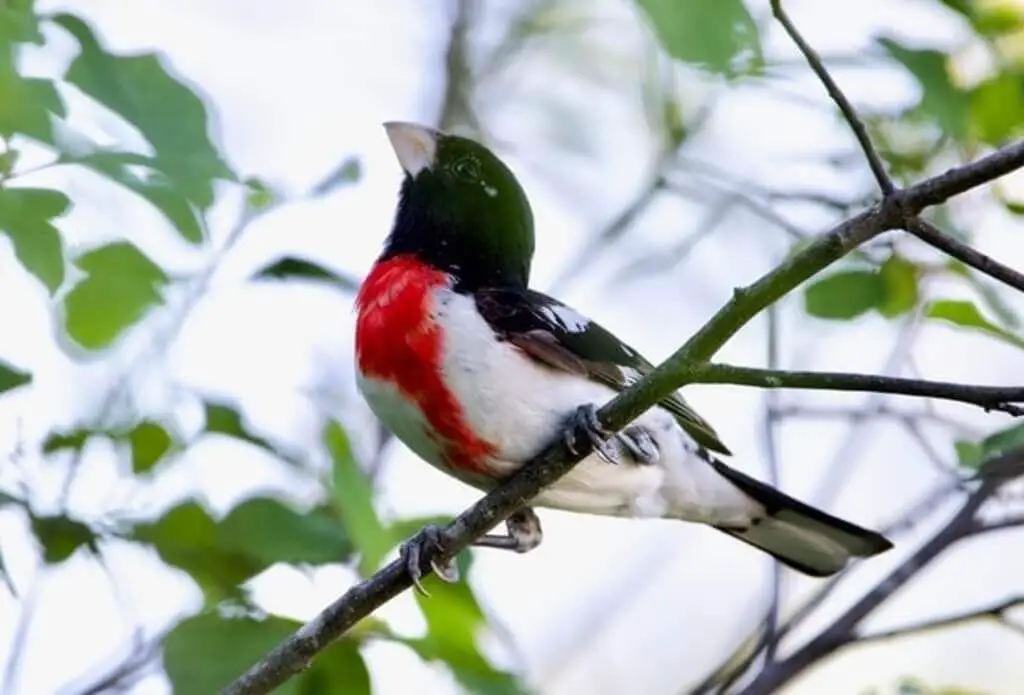Small birds with red chests are a delightful sight, adding a splash of color to our natural surroundings. These vibrant little creatures captivate bird enthusiasts and casual observers alike with their striking appearances and lively behaviors.
In this article, we explore eight charming small birds with red chests, highlighting their unique characteristics and habitats. Whether you’re an avid bird watcher or simply appreciate the beauty of nature, these birds are sure to fascinate and inspire.
Table of Contents
Types of Small Birds With Red Chests
House Finch
House finches are one of the most common birds in North America. Their range is vast, stretching from Canada to Panama and from Alaska to Central America. They are also found in Hawaii and the West Indies, although their populations there are smaller than those on mainland North America. They are known for their beautiful, bright red head and chest.
House finches nest and live in brushy habitats such as fields, thickets, woodlands, parks, gardens, and yards because they prefer tall trees with some foliage. House finches feed on weed seeds, grains, fruits, berries, insects such as grasshoppers, or other ground-dwelling invertebrates, but their favorite food is thistle seed.
- Length: 5.1 – 6.1 in. (13-15.5 cm)
- Weight: 15-29 g (0.53-1.02 oz)
- Wingspan: 8.1-10.1 in. (20.6-25.7 cm)
Purple Finch
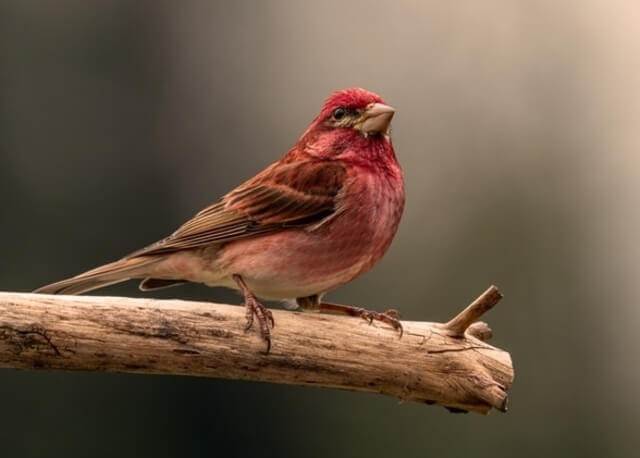
Purple finches are known for their rosy red head and chest feathers. These birds are fairly common in most parts of the United States and Canada but their population varies depending on the region they live in; for example, there are many more Purple Finches living in the eastern United States compared to those who live in the western part of the country.
The Purple Finch usually eats seeds from pine cones and other plants but has been known to occasionally hunt small insects like beetles or caterpillars for protein. They are not picky eaters! These birds also have been seen eating fruits such as grapes or blueberries that people leave out on their windowsills for them.
- Length: 4.5-6.5 in (11.4-16.5 cm)
- Weight: 19-33 g (0.6-1.1 oz)
- Wingspan: 8.6-10.4 in (21.8-26.4 cm)
Cassin’s Finch
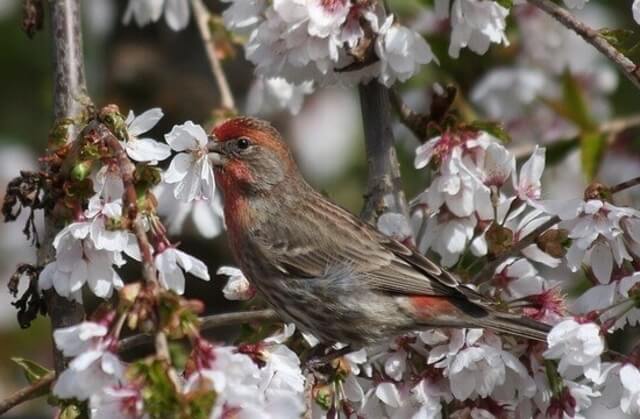
Cassin’s Finch is a small bird with a red crown, neck, and chest, a streaked-brown back, and light gray underparts. These birds are native to North America, living primarily in the west coast region of Canada and the United States, but also as far east as Texas. They can be found year-round in southern California, but have been seen wintering south into Mexico or Central America.
These birds can be found at elevations of up to 8,000 feet in montane pine-oak forests and high elevation grasslands, or meadows. The Cassin’s Finch has been known to eat insects such as ants, beetles, and spiders as well as seeds from various plants including yucca or mesquite pods.
- Length: 6.0-6.3 in (15-16 cm)
- Weight: 0.8-1.2 oz (24-34 g)
- Wingspan: 9.6-10.5 in (24.4-26.7 cm)
Common Linnet
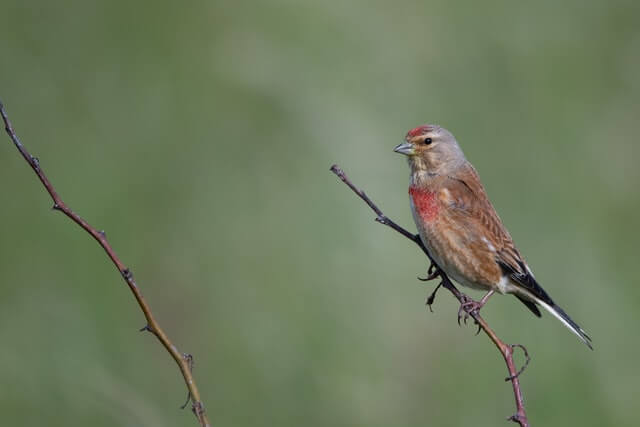
The Common Linnet are small birds native to Europe, the western Palearctic, and North Africa. Males have a gray head and throat, with a reddish-brown back, and a dark pink cap, and chest. Females are a dull brownish color in comparison to males. Linnet has been recorded in Ireland since at least 1771, with populations remaining widespread throughout much of the country despite ongoing declines elsewhere in Europe.
Common Linnets live in many habitats including open fields near woodland edges or close to farmland. Although they can be found on lawns or gardens feeding on insects but will also eat seeds or berries when available.
- Length: 5.5″-5.7 in. (14-14.5 cm)
- Weight: 13-21 g (0.52-0.75)
- Wingspan: 8.3″-10.1″ (21-25.7 cm)
Rose-breasted Grosbeak
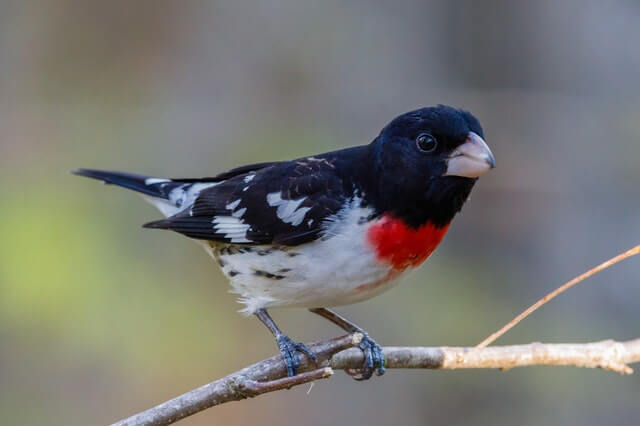
The Rose-breasted Grosbeak is a small North American migratory songbird with a beautiful rose-red breast, that resides in eastern North America, from the east coast to the west coast, and north to southern Canada. The majority of these birds live in parts of Canada, Mexico, and northern California but there are also some who have been spotted as far south as Central America.
This grosbeak prefers open woodlands with scattered trees, orchards, farmlands, and parks with shrubs and tall weeds as nesting sites. The birds are often seen feeding on seeds of pine cones at feeders in winter.
- Length: 7.0–8.9 in (17.8–22.6 cm)
- Weight: 32–67 g (1.13–2.4 oz)
- Wingspan: 10–14 in (25.4–35.6 cm)
Pine Grosbeak

Pine Grosbeaks are a large finch that is migratory. They live in northern North America and breed from Alaska to Newfoundland, Canada, and migrate south in the winter months as far as Mexico. These small birds nest close to trees or bushes for protection. Their range includes many different habitats but they prefer moist forests with plenty of evergreens, open woodland areas with brushy undergrowth, and even coastal pine woods.
They usually reside near water sources such as lakes or rivers but can also be found living inland and sometimes high up in trees to avoid predators below them. The male Pine grosbeak is mostly rose-red, with a grayish-black wings and tail, while the female is a greenish-yellow with gray on the back and wings.
- Length: 8.0-10.2 in (20.3-25.9 cm)
- Weight: 50-80 g (1.8 to 2.8 oz)
- Wingspan: 12.5-13.0 in (31.8-33 cm)
Vermilion Flycatcher
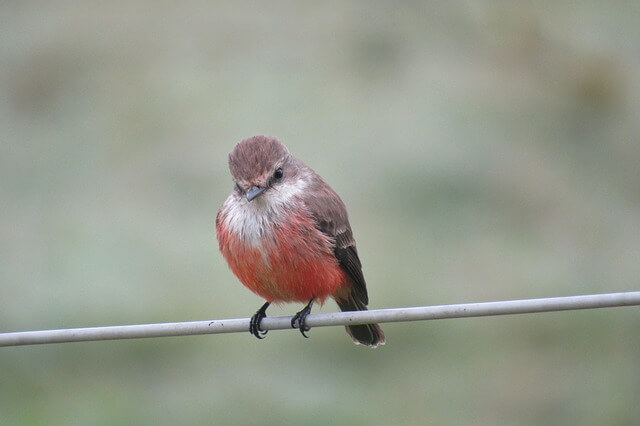
The Vermilion Flycatcher is a small, migratory bird that was originally found in the southwestern United States and Mexico. It has since expanded its range to include much of the eastern and western parts of North America. It nests from March through September, generally choosing an elevated spot on a tree or bush near water for nesting material.
They are active during spring and summer months but often spend wintertime at higher elevations. They tend to nest in thickets, bushes, and dense tree foliage near water sources such as streams or rivers. These colorful little birds have a diet of insects and spiders which they hunt for in the branches above their nests.
- Length: 5.0–5.7 in (12.7–14.5 cm)
- Weight: 10-15 g (0.35-0.53 oz)
- Wingspan: 9.5-10.0 in (24.1-25.4 cm)
Common Redpoll

The Common Redpoll is a small songbird in the finch family. It is found primarily in the boreal forests of Canada and Alaska, but also as far south as Pennsylvania during the winter months. The bird’s range includes the Northern Atlantic coast from Nova Scotia to Maine, and westward across Quebec into Minnesota.
The Common Redpoll lives primarily on insectivores but will also eat berries, mosses and lichens, and on seeds from birch trees, which it caches in bark crevices for later use when food becomes scarce. During breeding season they can be found in areas of coniferous trees such as pine, spruce, fir, hemlock or larch.
- Length: 4.5-5.6 in (11.4-14.2 cm)
- Weight: 11-20 g (0.39-0.71 oz)
- Wingspan: 7.5-9.0 in (19-22.9 cm)

